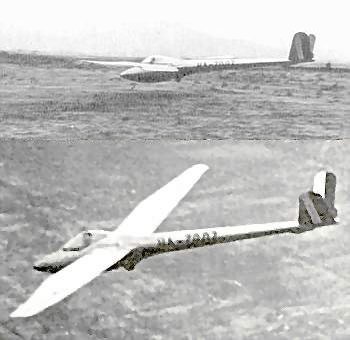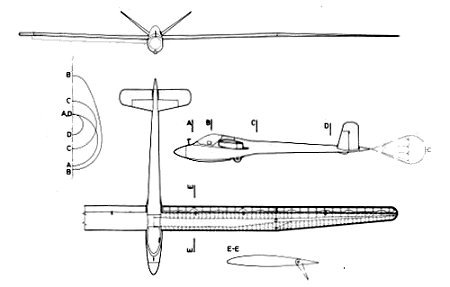HUNGARIAN
GLIDERS
1933-2000
| Type designation: |
OE-01 (R-20) |
| Name: |
OE-01 |
| Designer: |
Ernő RUBIK, aerodynamics: Márton PAP, structure: Sándor BOHN, József ZAPPEL, Gábor JEREB and Géza KÓKAI |
| Class: |
High performance |
| General arrangement: |
Mid-wing, cantilever, fixed wheel, V-tail, tail parachute |
| Crew: |
1 |
| First flight: |
May 14, 1951 |
| Manufacturer: |
Central Workshop of Hungarian Aeronautical Association, Dunakeszi |
| Number of built: |
1 |

Short history:
During the design work of the R-22S Június-18 in the design office of the OMRE (Hungarian National Flying Association) headed by Ernő Rubik, had came up the idea to develop a special, experimental, competition and record-breaking glider. The evolving concept called for a minimum sinking speed of only slightly over 0,5 m/s and for a flat performance curve with a best gliding ratio in the range of 32-35. To meet this requirements an aspect ratio of over 23 was selected, however the wing loading was kept at a value generally used on contemporary gliders, namely in the range of 20 kg/m2. The designers' intention was to use a laminar airfoil and a light metal structure to get a smooth surface.
As the customer, the MRSz (Hungarian Aeronautical Association), asked for a short delivery date after the concept had been presented, and the Central Workshop of the MRSz, where the glider was to be built, had no experience with light-metal structures, the light-metal structure concept had been dropped and a traditional all wooden structure was designed.
The OE-01 first flew at May 14, 1951. The first test flights had shown much better performances then that of the Június-18, as well as good handling characteristics. However the predicted better performances at higher speed range failed to be realized. No true laminar flow developed around the wing due to the quality of the surface and the wing deformation at higher gliding speeds. Unfortunately the OMRE's design office had been dissolved during the construction and no able staff was available to evaluate the test flights and to prepare the necessary modifications.
The glider was not certified for aerobatics, spin and cloud flying.
No exceptional flights were performed with the glider. Pilots had an aversion to fly the glider because of the great span, the shallow height of the main spar and the flexibility of the wing, which was unusual at those times. The glider was discarded at the end of the '50s.
Structure: -
Wing:
The wing of the cantilever, mid-wing, all wooden high performance glider consisted of three parts. The center part featuring a rectangular planform had a span of 9 m and a chord of 0,9 m. The outer panels were tapered with rounded wingtips. The flaps with plain leading edge and with a chord length of 0,24 m, was fitted on to the center part. The flap positions were -0,5, +8 and +80 degrees. The ailerons occupied the whole span of the outer panels. The wing had a shallow gull form to reduce the possibility of the wingtips to get stuck on the ground.
As no laminar airfoil data were available in Hungary at those times, taking the contour of NACA 23012 as a starting point Márton Pap designed a new airfoil. He modified the thickness of the airfoil chordwise according to a predefined pressure distribution. The greatest thickness of the 12 % airfoil was at the 45% of the chord. The airfoil characteristics were determined at the wind tunnel of the Technical University of Budapest.
The height of the main spar at the center part of the wing was 0,108 m and it was 0,32 wide chordwise. It was a box spar with six webs. The size of this box gradually decreased toward the wingtips. The whole surface of the wing was covered by plywood. The fuselage connected to the center part of the wing by two longitudinal bolts. The outer panels connected to the center part by one vertical and one longitudinal bolt. The laps and the ailerons were covered by fabric.
Fuselage:
The fuselage had a very tight cross section at the range of the pilot seat. Behind the seat the cross section gradually turned into a cone shaped tail boom the end of which had a diameter of 0,16 m. The landing gear consisted of a small fixed wheel located in front of the c.g. of the empty glider, and a nose and a tail skid. Both skids had rubber springs. Into the rear part of the fuselage, a 1,1 m diameter tail parachute was fitted in a small, detachable cone. A spring helped the chute to deploy. It was possible to retract the deployed parachute in flying.
Tail unit:
The tail boom carried the V formed tail surfaces being 114 angles to each other. A push-rod control mechanism was used for the V tail.
.jpg)

| Dimensions: |
| Wing: |
| Span, m: |
18 |
| Area, m2: |
13,95 |
| Aspect ratio: |
23,3 |
| Chord (root), m: |
0,9 |
| Chord (tip), m: |
0,4 |
| Airfoil (root), m: |
Laminar (Pap) |
| Airfoil (mid-span), m: |
Laminar (Pap) |
| Airfoil (tip), m: |
Laminar (Pap) |
| Dihedral, degree: |
3,0 |
| Sweep, degree: |
0/3,82 |
| Washout: |
-2,5 degrees geometric |
| Aileron: |
| Span, m: |
4,5 |
| Mean chord, m: |
0,24 |
| Total area, m2: |
1,9 |
| Balancing: |
None |
| Flap: |
| Type: |
Plain |
| Area, m2: |
1,94 |
| Relative length, %: |
0,5 |
| Movement (+/-), degree: |
-5/80 |
| Airbrakes: |
| Type: |
Retractable and detachable tail parachute |
| Horizontal stabilizer: |
| Span, m: |
2,62 (projection) |
| Area, m2: |
1,7 (projection) |
| Elevator: |
| Span, m: |
1,7 (projection) |
| Area, m2: |
0,57 (projection) |
| Airfoil: |
NACA 0009 |
| Balancing: |
Aerodynamic |
| Trim: |
Yes |
| Vertical stabilizer and rudder: |
| Total area, m2: |
2x0,69 (projection) |
| Rudder area, m2: |
2x0,44 (projection) |
| Balancing: |
Aerodynamic |
| Fuselage: |
| Length, m: |
7,5 |
| Width, m: |
0,66 |
| Height: |
0,95 |
| Cross section, m2: |
0,51 |
| Landing gear: |
| Type: |
Fixed, in front of empty c.g. |
| Wheel diameter, m: |
0,26 |
| Masses: |
| Wing, kg: |
? |
| Fuselage, kg: |
? |
| Tail unit, kg: |
? |
| Empty glider, kg: |
190 |
| Gross, kg: |
290 |
| Ballast, kg: |
None |
| Wing loading, kg/m2: |
20,79 |
| Speeds: |
| VNE, km/h: |
220 |
| Max. speed with open airbrakes, km/h: |
? |
| Max. aerotow speed, km/h: |
125 |
| Max. winch speed, km/h: |
100 |
| Max. speed in rough air, km/h: |
? |
| Stall speed, km/h: |
65 |
| Performance: |
| Min. sink, m/s (at gliding speed, km/h): |
0,65/75 |
| Best L/D (at gliding speed, km/h): |
32,4/80 (calculated) |
| Start methods: |
Winch, Aerotow |

Origin of data and 3-view drawing:
Jereb Gábor: Magyar vitorlázó repülőgépek, Műszaki Könyvkiadó, 1988, Budapest
(Gábor JEREB: Hungarian Gliders, Technical Publishing House, 1988, Budapest)
Gábor FEKECS E-mail: fekecs.gabor@t-online.hu

.jpg)
